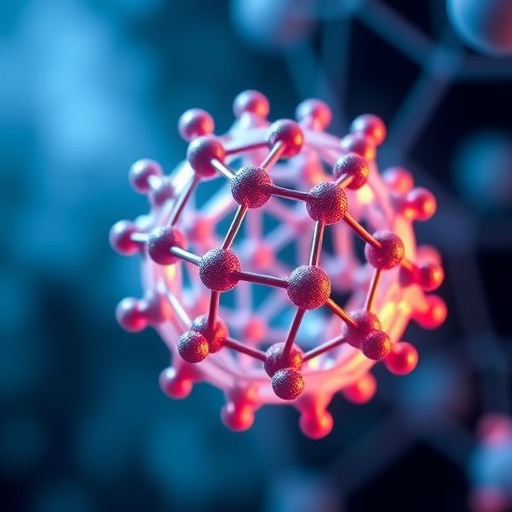In a groundbreaking advancement poised to revolutionize cancer therapeutics, researchers from Okayama University in Japan have developed an innovative nanomaterial that dynamically alters its charge in response to the acidic microenvironment of tumors, enabling precise and highly efficient drug delivery. This pioneering study, led by Professor Yuta Nishina in collaboration with international experts including Assistant Professor Yajuan Zou and Professor Alberto Bianco from the University of Strasbourg, delves into the challenges and possibilities of pH-responsive engineered nanomaterials (ENMs) tailored for targeted cancer treatment. Published in the journal Small on June 1, 2025, their work highlights not only the remarkable capabilities of graphene oxide-based nanocarriers but also provides unprecedented insights into their behavior within living systems.
This challenge motivated Professor Nishina’s team to engineer a novel graphene oxide nanocarrier with a “charge-reversible” surface that tactically evades immune surveillance in the bloodstream while activating its tumor-targeting properties within the acidic tumor environment. The key innovation lies in grafting hyperbranched amino-rich polyglycerol (hPGNH₂) onto the graphene oxide sheets and then functionalizing this composite with dimethylmaleic anhydride (DMMA). This chemical modification confers pH-sensitive charge conversion: at physiological pH (~7.4), the surface remains negatively charged, minimizing protein adsorption and immune recognition. However, upon encountering the slightly acidic milieu typical of tumor tissues (pH ~6.5 or lower), the surface charge switches to positive, enhancing electrostatic interactions with the negatively charged cell membranes of cancer cells, thereby promoting cellular internalization.
.adsslot_JuPMmVR5sF{width:728px !important;height:90px !important;}
@media(max-width:1199px){ .adsslot_JuPMmVR5sF{width:468px !important;height:60px !important;}
}
@media(max-width:767px){ .adsslot_JuPMmVR5sF{width:320px !important;height:50px !important;}
}
ADVERTISEMENT
A critical aspect of this study was the systematic evaluation of three GOPG-DMMA nanomaterials differentiated by the density of surface amino groups, labeled GOPGNH115, GOPGNH60, and GOPGNH30. These variants allowed the researchers to fine-tune the balance between immune evasion and tumor targeting. Through extensive in vitro and in vivo experimentation, GOPGNH60-DMMA emerged as the optimal candidate due to its finely calibrated positive charge in acidic conditions and minimized nonspecific interactions in the bloodstream. This equilibrium led to higher tumor accumulation and improved cell uptake in murine cancer models, with significantly reduced off-target effects compared to the other variants.
The dynamic nanobiointerface engineered in this material represents a paradigm shift in the design of pH-responsive drug carriers. By modulating the physicochemical properties of the nanomaterial post-administration, the researchers could strategically dictate its biological fate. The implications extend beyond targeted delivery; the capacity to direct nanocarriers into specific acidic intracellular organelles such as lysosomes and endosomes opens avenues for next-generation therapies that act precisely where their payloads are most effective, potentially overcoming multidrug resistance and enhancing therapeutic indices.
Dr. Zou reflects on the broader significance of these findings: precise control over nanomaterial surface chemistry in response to physiological stimuli paves the way for “theranostic” platforms—integrated systems that combine diagnostics with therapeutics. Such dual-function nanocarriers could simultaneously visualize, monitor, and treat tumors in real time, dramatically improving personalized medicine approaches. This study marks a milestone in the iterative refinement of smart nanomedicines, showcasing how interdisciplinary collaboration between material science, chemistry, and biology can yield transformative medical technologies.
Strategically, this research is embedded within an ambitious international partnership, the IRP C3M program initiated in 2025 between Okayama University and the French National Centre for Scientific Research (CNRS). The program endeavors to push the frontiers of nanomaterials engineered for health applications, optimizing biocompatibility, targeting specificity, and functional versatility. Continued investigation into the molecular mechanisms governing nanomaterial-protein and nanomaterial-cell interactions is expected to deepen understanding and fuel the design of even more sophisticated carriers.
Technical challenges remain, particularly the necessity to emulate complex human tumor microenvironments in animal models and ensure that laboratory efficacy can be translated safely and effectively to clinical settings. Nonetheless, the demonstration that surface charge can be modulated dynamically and reversibly in vivo without eliciting significant immune responses or systemic toxicity suggests strong translational potential. These findings illuminate a clear path toward developing nanomedicines capable of intelligent decision-making, a characteristic integral to the future of personalized oncological therapy.
Professor Nishina’s contributions to the field extend beyond this study, as his multidisciplinary expertise in nanocarbons and biomedical applications informs a portfolio of research aimed at harnessing carbon nanomaterials for catalysis, energy devices, and, crucially, biomedicine. With over 210 peer-reviewed publications, multiple patents, and collaborations spanning the globe, his leadership underscores the vitality of convergent science in solving pressing healthcare challenges.
The study exemplifies the power of precise chemical engineering in redefining drug delivery modalities. By intercepting the critical balance between immune evasion and tumor penetration, nanomaterials like GOPG-DMMA herald a new generation of intelligent, responsive therapeutic platforms. As these innovations progress toward clinical translation, the vision of cancer treatment shifting from broadly systemic approaches to finely-tuned, patient-specific therapies becomes increasingly achievable.
Subject of Research: Animals
Article Title: Polyglycerol-Grafted Graphene Oxide with pH-Responsive Charge-Convertible Surface to Dynamically Control the Nanobiointeractions for Enhanced in Vivo Tumor Internalization
News Publication Date: 1-Jun-2025
Web References: https://doi.org/10.1002/smll.202503029
Image Credits: Professor Yuta Nishina from Okayama University
Keywords: Health and medicine; Cancer; Cancer treatments; Nanomedicine; Cancer medication; Targeted drug delivery; Cancer immunology; Personalized medicine; Tumor regression; Drug interactions
Tags: biological behavior of nanomaterialscancer therapeutics advancementscollaborative cancer research initiativesengineered nanomaterials for cancergraphene oxide nanomaterialsinnovative drug delivery systemsnanotechnology in cancer treatmentovercoming chemotherapy limitationspH-responsive nanocarriersprecision medicine in oncologytargeted cancer drug deliverytumor microenvironment response





